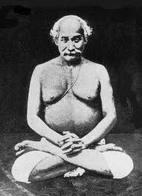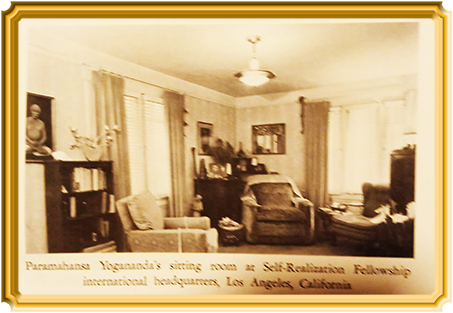
This is the story of Lahiri Mahasaya’s original photograph.
Lahiri Mahasaya in his original photo is seen with his laughing round bare belly. That photo has a wonderful history: it could only be taken when Lahiri approved to be photographed – taken without his approval the photo had shown an inexplicable empty spot where Lahiri had been sitting amongst his disciples. “I am Spirit,” the Master smiled (see Autobiography of A Yogi).
The same photo saved young Yogananda from a dreadful death when he was stricken with cholera: “A blinding light” came from the photo, “enveloping my body and the entire room.” Yogananda was instantaneously healed.
Many times, we read, while Yogananda was meditating in front of that photo, Lahiri Mahasaya would emerge from the frame and became a living form, sitting down in front of him. When Yogananda then tried to touch the feet “of his luminous body”, he never succeeded: Lahiri always flew back, becoming a picture again.
The same holy photo protected a woman disciple, when furious lightening struck her house- even the book beside her. She desperately prayed to Lahiri, bowing to the photo, and was saved miraculously, as if by “sheets of ice”.
Lahiri Mahasaya said regarding his photo, “if you deem it a protection, then it is so; otherwise it is only a picture.”
It was one of Yogananda’s “most precious possessions,” as he writes. “Given to Father by Lahiri Mahasaya himself, it carries a holy vibration.”
In 1935/36, as we read in the 1998 12th edition of the Autobiography of a Yogi, Yogananda asked a Bengali artist (probably Sananda, his brother, who also painted Babaji) to create a painting of Lahiri. That became the picture we usually see today. On it, Lahiri appears much more mild (“grandfatherly”), but less mystical and powerful than on the original photo.
In 1946, when Yogananda first offered his Autobiography of a Yogi to the world he didn’t use the painting, however, but chose to print the sacred original photo of Lahiri Mahasaya.
It may be that he received some bewildered feedback from some of his readers. Or the quality of the photo was simply not sufficient. Whatever the case, for the 3rd 1951 Autobiography of a Yogi-edition, Yogananda chose to print the artist’s painting of Lahiri – thus the original photo disappeared from the Autobiography of a Yogi. However, the painting still showed Lahiri’s bright bare belly.
Some time after the Master’s passing, this bare belly apparently became a bit too bold for some tastes. Thus in the 1954 5th edition we find Lahiri’s chest beautifully dressed. The cloth, as one reads in a footnote of the 7th edition, was later added by a “Bengali artist.”
After half a century, in the 1998 12th edition, Lahiri’s original miraculous photo suddenly reappeared. The photo shown there, however, is actually worse in quality than what is available. At Shibindu Lahiri’s ashram in Varanasi you may admire and photograph one of the original prints: you will see much less stark black/white contrast, will see Lahiri’s open eyes, and a quaint backdrop curtain.
In that same 1998-Autobiography of a Yogi we also find the explanation why the painting had been used for all these years: Yogananda had later designated it as the formal portrait of Lahiri for SRF publications; and that it hangs in Yogananda’s Mount Washington sitting room.
Nowadays, if you visit Mount Washington, you will indeed find that painting hanging there, with a properly dressed Lahiri Mahasaya. But the observant eye discovers that this is actually a little adjustment that was made to the otherwise so carefully protected quarters of Yogananda: on a photo in the book “Paramahansa Yogananda – In Memoriam” (below) you see how he had enjoyed the painting: Lahiri was beautifully and freely bare-bellied (poor nuns!)
Lahiri-Joy to all, whether of “proper” or of “free” taste!

